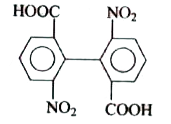Which of the following compounds after complete hydrogenation will form three monochloro structural isomeric products ?


The correct Answer is:C, D
To determine which compound will form three monochloro structural isomeric products after complete hydrogenation, we can follow these steps:
Step 1: Identify the Compound
We need to identify the compound from the options provided that, upon complete hydrogenation, will yield a saturated hydrocarbon (alkane) with the potential for three distinct monochloro derivatives.
Step 2: Perform Complete Hydrogenation
Complete hydrogenation of an unsaturated compound (like an alkene or alkyne) converts it into a saturated compound (alkane). For example, if we have a compound like an alkene, it will convert to hexane (C6H14) after hydrogenation.
Step 3: Structure of the Resulting Alkane
After hydrogenation, we will have a straight-chain alkane. For instance, if the compound is 1-hexene, the resulting product after hydrogenation will be hexane (C6H14).
Step 4: Identify Possible Monochloro Derivatives
Now we need to identify the positions where chlorine can be substituted on the hexane molecule. The positions are as follows:
- Chlorine can be substituted at the 1st carbon (C1).
- Chlorine can be substituted at the 2nd carbon (C2).
- Chlorine can be substituted at the 3rd carbon (C3).
Step 5: Check for Structural Isomerism
When chlorine is substituted at C1, C2, and C3, we need to check if these substitutions yield unique structural isomers:
1. 1-chlorohexane (Cl at C1)
2. 2-chlorohexane (Cl at C2)
3. 3-chlorohexane (Cl at C3)
Substituting chlorine at C4 would yield a compound that is structurally identical to 2-chlorohexane due to symmetry, and substituting at C5 would yield a compound that is identical to 1-chlorohexane. Thus, we only have three distinct structural isomers.
Conclusion
The compound that, after complete hydrogenation, forms three monochloro structural isomeric products is option C.
---
We need to identify the compound from the options provided that, upon complete hydrogenation, will yield a saturated hydrocarbon (alkane) with the potential for three distinct monochloro derivatives.
Complete hydrogenation of an unsaturated compound (like an alkene or alkyne) converts it into a saturated compound (alkane). For example, if we have a compound like an alkene, it will convert to hexane (C6H14) after hydrogenation.
After hydrogenation, we will have a straight-chain alkane. For instance, if the compound is 1-hexene, the resulting product after hydrogenation will be hexane (C6H14).
Now we need to identify the positions where chlorine can be substituted on the hexane molecule. The positions are as follows:
- Chlorine can be substituted at the 1st carbon (C1).
- Chlorine can be substituted at the 2nd carbon (C2).
- Chlorine can be substituted at the 3rd carbon (C3).
When chlorine is substituted at C1, C2, and C3, we need to check if these substitutions yield unique structural isomers:
1. 1-chlorohexane (Cl at C1)
2. 2-chlorohexane (Cl at C2)
3. 3-chlorohexane (Cl at C3)
The compound that, after complete hydrogenation, forms three monochloro structural isomeric products is option C.
Topper's Solved these Questions
- STRUCTURAL IDENTIFICATIONBook:RESONANCE ENGLISHChapter:STRUCTURAL IDENTIFICATIONExercise:Advanced level Problems (Part-III)
Explore 12 Videos
- STRUCTURAL IDENTIFICATIONBook:RESONANCE ENGLISHChapter:STRUCTURAL IDENTIFICATIONExercise:Advanced level Problems (Part-I)
Explore 29 Videos
- STEREOISOMERISMBook:RESONANCE ENGLISHChapter:STEREOISOMERISMExercise:EXERCISE (PART III : PRACTICE TEST-2 (IIT-JEE (ADVANCED PATTERN))
Explore 23 Videos
- SURFACE CHEMISTRYBook:RESONANCE ENGLISHChapter:SURFACE CHEMISTRYExercise:Section - 5
Explore 1 Video
Similar Questions
Knowledge Check
Which of the following compounds exhibit optical isomerism?
A BH2C=C=CH2C
BH2C=C=CH2C D
D
Which of the following compound shows optical isomerism ?
ACH3CH2CH3BCH2OHCHOHCH2OHCCH3CHOHC2H5DNone of theseWhich of the following compounds exhibits linkage isomerism?
A[Co(en)3]Cl3B[Co(NH3)6][Cr(en)3]C[Co(en)2(NO2)Cl]BrD[Co(NH3)5Cl]Br2
Which of the following compound show optical isomerism?
View SolutionWhich of the following compounds shows geometrical isomerism ?
View Solutionwhich of the following compound will show stereo isomerism?
View SolutionWhich of the following compounds display geomertical isomerism ?
View SolutionWhich of the following compound will show optical isomerism
View Solution


 Total number of monochloro structure products
Total number of monochloro structure products